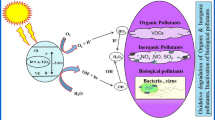Abstract
While the primary function of concrete is structural, its pervasiveness in our society lends it to other functions and creates the need for it to maintain its integrity and aesthetic quality. Therefore, concrete with added functionality—for example, self-cleaning characteristics and the ability to remove pollutants—is desirable. Heterogeneous photocatalysis (e.g., gas–solid or liquid–solid catalytic processes caused by light irradiation) by semiconductor particles or coatings has now reached a high level of development and is a promising technology for the reduction of global environmental pollutants. Among the various semiconductor materials, TiO2 in the form of anatase has attracted wide interest, due to its strong oxidizing power under near-UV radiation, its chemical stability when exposed to acidic and basic compounds, its chemical inertness in the absence of UV light, and the absence of toxicity. TiO2 has proved very effective in the reduction of pollutants such as NOx, aromatics, ammonia, and aldehydes. Surprisingly, the use of TiO2 in combination with cementitious materials has shown a favorable synergistic effect in the reduction of pollutants. These new materials have already found relevant applications in self-cleaning building walls and in the reduction of urban pollutants.
Similar content being viewed by others
References
N. Serpone and E. Pellizzetti, Photocatalysis: Fundamentals and Applications (John Wiley & Sons, New York, 1989).
M. Kaneko and I. Okura, Photocatalysis: Science and Technology (Springer, Berlin, 2002).
A. Fujishima, “Nanotechnology and Photo-catalysis: Important Science and Technology for Comfortable Atmosphere,” presented at the Shanghai International Nanotechnology Cooperation Symposium (SINCS 2002), Shanghai, China, July 30–Aug 1, 2002.
A. Fujishima, K. Hashimoto, and T. Watanabe, TiO2 Photocatalysis: Fundamentals and Applications (BKC, Tokyo, 1999).
A. Fujishima, T.N. Rao, and D.A. Tryk, J.Pho-tochem. Photobiol., C 1 (2000) p.1.
I. Sopyan, S. Murasawa, K. Hashimoto, and A. Fujishima, J. Photochem. Photobiol., A 98 (1996) p.79.
I. Sopyan, S. Murasawa, K. Hashimoto, and A. Fujishima, J.Electroanal. Chem. 415 (1996) p.183.
R. Wang, K. Hashimoto, A. Fujishima, M. Chikumi, E. Kojima, A. Kitamura, M. Shimohigoshi, and T. Watanabe, Nature 388 (1997) p.431.
R. Wang, K. Hashimoto, A. Fujishima, M. Chikuni, E. Kojima, A. Kitamura, M. Shimohigoshi, and T. Watanabe, Adv. Mater. 10 (1998) 135.
M. Formenti, F. Juillet, P. Meriendeau, and S.J. Teichner, Chem. Technol. Fuels Oils 1 (1971) p.680.
P. Gravelle, F. Juillet, P. Meriendeau, and S.J. Teichner, Discuss. Faraday Soc. 52 (1971) p. 140.
L. Cassar and C. Pepe, “Hydraulic binder and cement compositions containing photocat-alyst particles,” European Patent No. WO 9805601 (February, 12, 1998).
L. Cassar, C. Pepe, N. Pimpinelli, R. Amadelli, and T. Bonato, Seminario FAST–Materiali: Ricercae Prospettive Tecnologiche alle Soglie del 2000 (Federazione delle associazioni scientifiche e techniche, Milano, Italy, 1997) p.591.
L. Cassar, C. Pepe, N. Pimpinelli, R. Amadelli, and L. Antolini, “New Cement-Based Materials and Photocatalysis,” presented at Rebuilding the City of Tomorrow, 3rd Eur. Conf. REBUILD (Barcelona, Spain, 1999).
R. Amadelli, C. Pepe, N. Pimpinelli, and L. Cassar, “Photoactive Materials Based on Doped-TiO2/Cement Matrices,” Proc. Int. Symp. on Environment Conscious Materials and Systems for Sustainable Development (RILEM, Koriyama, Japan, 2004) in press.
L. Cassar, C. Pepe, G. Tognon, G.L. Guerrini, and R. Amadelli, in Proc. 11th Int. Congress on the Chemistry of Cement (ICCC), Vol. IV (Durban, South Africa, 2003) p.2012.
L. Cassar and C. Pepe, “Use of organic additives for the preparation of cementitious compositions with improved properties of constancy of color,” U.S. Patent No.6,117,229 (September 12, 2000).
F. Vallée, B. Ruot, L. Bonafous, L. Guillot, N. Pimpinelli, L. Cassar, A. Strini, E. Mapelli, L. Schiavi, C. Gobin, H. André, N. Moussiopoulos, A. Papadopoulos, J. Bartzis, T. Maggos, R. McIntyre, C. Lehaut-Burnouf, A. Henrichsen, P. Laugesen, R. Amadelli, D. Kotzias, and P. Pichat, “Innovative Self-Cleaning and De-Polluting Facade Surfaces,” to be presented at CIB World Building Congress2004, May 2–7, 2004, Toronto, Canada.
Rights and permissions
About this article
Cite this article
Cassar, L. Photocatalysis of Cementitious Materials: Clean Buildings and Clean Air. MRS Bulletin 29, 328–331 (2004). https://doi.org/10.1557/mrs2004.99
Published:
Issue Date:
DOI: https://doi.org/10.1557/mrs2004.99




